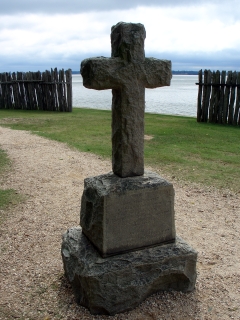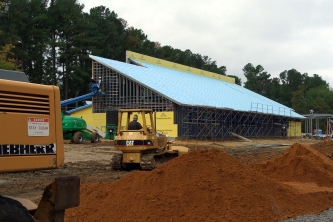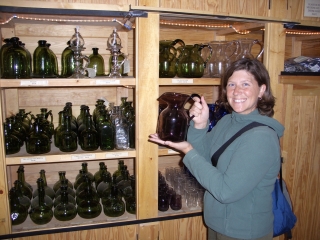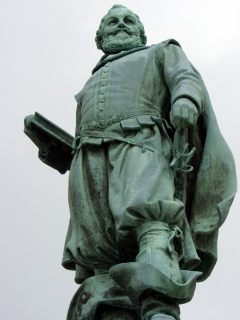NPS Website; Local Website; NPS Colonial NHP Website; Local Colonial NHP Website
WHAT IS IT?
 Location of the first successful English colony in the New World, led in 1607 by Capt. John Smith.
Location of the first successful English colony in the New World, led in 1607 by Capt. John Smith.BEAUTY (3/10)
Historic Jamestown is a visual mess. Haphazardly placed monuments and statues take their place among town ruins in various stages of excavation.
Hurricane Isabel destroyed the Park’s old VC and other permanent structures in 2003. A new Visitor Center is under construction and should open in time for the Site’s 400-year anniversary in 2007. As a result, orange plastic fences and yellow police tape cordon off Historic Jamestown sites, port-o-potties stand next to the Pocahontas statue and no photograph can avoid a 21st Century mechanized construction intrusion.
Cranes, workers, dump trucks and assorted decibel-soaring equipment successfully stake their claim as your visit’s most indelible memory. The only respite from the mechanistic madness is the five-mile Island Drive Loop that travels through the quiet, shimmery mosquito-laden marshlands of Jamestown Island.
HISTORICAL INTEREST (9/10)
During a visit to the Independence NHP in Philadelphia, a docent at the American Philosophical Society averred to Michael that everything wrong in this country is traceable to our English roots. She clearly has not studied Colonial Spanish history. The two grandest historic revelations to sprout at Jamestown, tobacco farming and its conjoined twin slavery, were nourished by the English but learned from the Spanish.
In 1617, John Rolfe experimented with new strains of tobacco, imported from the Spanish West Indies. The resulting leaf proved tastier than the native species and much more profitable. The peninsula soon moved towards mass tobacco production, a society flourished and, as the Park brochures state, “America began”.
Indeed, without tobacco farming and slavery, America would have ceased to exist. The democratic ideals of the founding fathers, our economic power, the notion of religious freedom and tolerance, and the ideas of the Age of Enlightenment put into practice; poof, gone with the wind. We are tobacco; it has always spurred our nation’s blood.
The first 10 years of British life at Jamestown are notable because of the colonists’ sheer incompetence and absolute failure to survive. These settlers starved to death instead of growing crops and turned to cannibalism rather than kill the innumerable rabbits, deer, squirrel and other small game that teemed around them. It was not until 1617 that the colony became a moneymaking success.
In 1619, African slaves were brought to Jamestown to work the tobacco crop, the first instance of slavery in the English New World. Slavery was not new to the Americas, the Spanish were using it to fuel an empire, but was new to English outposts. Virginia did not become inundated with African slave labor until after the 1676 Bacon’s Rebellion but the seeds were sown at Jamestown.
 CROWDS (2/10)
CROWDS (2/10)The Jamestown site was stuffed to the gills, even on a mid-week, late-October morning. The Park’s space-to-tourist ratio is exacerbated by the ongoing construction.
Visitors, most of them in the septuagenarian set, walk around like guillotined chickens. No one knows where to go because the makeshift VC and signage are inadequate. The Park shows the 40+ year-old intro video in an educational mobile facility with no air conditioning and no ventilation.
Confusion reigns at the current incarnation of Jamestown NHS because just around the corner, less than a mile away, is the Jamestown Settlement, a living history Virginia State Park attraction. The State Park has reënactors and replicas of the 1607 ships. The Settlement also has a separate entrance fee. We heard dozens of guests wonder aloud, “where are the ships?” and “why did we have to pay twice”.
EASE OF USE/ACCESS (4/5)
Jamestown NHS is located a few miles southwest of the tourist beehive of Colonial Williamsburg. Numerous signs from I-64, Exit 234 point you towards the Jamestown Settlement. You can follow these signs to the NPS site because the two Museums are right next to each other. Handily, we saw a sign at nearly every intersection. You should too.
The 25-mile long Colonial Parkway connects Colonial NHP’s two major sections, Jamestown NHS and Yorktown Battlefield. The Parkway meanders amiably, allowing a stoplight and Interstate-free drive.
CONCESSIONS/BOOKSTORE (4/5)
Jamestown NHS’s top attraction is the Glasshouse and its adjoining store. Here you can purchase stunning and affordably priced glass blown on-site, replicating the output of early 17th-Century Polish and German artisans.
The Park’s book selection was good but hardly definitive. Do your shopping for read-ables at Colonial Williamsburg’s jumbo-sized bookstore.
COSTS (2/5)
 Collectively, Jamestown NHS and Yorktown Battlefield are known as Colonial National Historical Park. The National Parks Pass (NPP) provides free entry into both Colonial NHP sites.
Collectively, Jamestown NHS and Yorktown Battlefield are known as Colonial National Historical Park. The National Parks Pass (NPP) provides free entry into both Colonial NHP sites.If you do not have the NPP, Jamestown NHS charges $8 per adult. Yorktown Battlefield charges $5 per adult. A combo pass is $10 per adult.
The Virginia State Park, Jamestown Settlement, costs $11.75 per adult. The Commonwealth of Virginia also runs its own Park at Yorktown, called the Yorktown Victory Center, which runs $8.25 per adult. Their combo pass is $17. Jamestown Settlement and the Yorktown Victory Center are not affiliated with the National Park Service; your NPP does not work there.
RANGER/GUIDE TO TOURIST RATIO (1/5)
If there were Rangers at Jamestown NHS, they eluded our probing eyes.
TOURS/CLASSES (4/10)
The current educational situation at Jamestown NHS is revoltingly bad. The mentions of Bacon’s Rebellion, tobacco, slavery, English common law, cannibalism, etc… are fleeting at best. The Site does not even tell the dubious Pocahontas story. We trust that this will change once the new Visitor Center opens. Do not expect to learn anything until that date.
Our generous score comes from our pleasant experience at the Jamestown Glasshouse. Costumed artisans blow glass while a staff member explains the mesmerizing art. The finished products (assorted stemware, ewers and lamps) are sold both under the Glasshouse canopy and at NPS Visitor Centers throughout the United States.
 FUN (4/10)
FUN (4/10)Gab had tons of fun at the Glasshouse. Michael was thoroughly bored. Neither of us enjoyed our time at the Historic Jamestowne site. It is difficult to transport your imagination back to 1607 while bulldozers drown out your every thought. Even though we are not intrigued by the Pocahontas story, we did want to hear it. Instead, we were met with signs beckoning us to return in 2007. All of our learning came through self-induced historical speculation based on our own readings. If you come to learn about Jamestown you will leave with the same desire.
WOULD WE RECOMMEND? (4/10)
Yes, just not until 2007 when the new VC and Museum open. Maybe then we can come back and adjust our score upward.
TOTAL 37/80
www.usa-c2c.com
© 2005